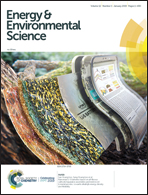Fabrication of CdS hierarchical multi-cavity hollow particles for efficient visible light CO2 reduction†
Abstract
Designing advanced structures for semiconductor photocatalysts is an effective approach to enhance their performance. However, it is not easy to fabricate functional photocatalytic materials with complex nano-architectures. Here we have developed a sequential solution growth, sulfidation and cation-exchange strategy to fabricate CdS hierarchical multi-cavity hollow particles (HMCHPs). This strategy starts with the growth of Zn-based zeolitic imidazolate framework (ZIF-8) onto cobalt glycerate (Co-G) solid spheres. Sulfidation of the obtained Co-G@ZIF-8 composite particles leads to the formation of CoSx@ZnS HMCHPs, which are converted into CdS HMCHPs via a cation-exchange reaction. Owing to the favourable properties of the well-defined hierarchical hollow structure, the CdS HMCHPs exhibit enhanced activity for photocatalytic CO2 reduction compared with other CdS photocatalysts with solid and common hollow structures. The performance of CdS HMCHPs can be further promoted by loading of Au to reach a CO generation rate of 3758 μmol h−1 g−1 under visible light irradiation.



 Please wait while we load your content...
Please wait while we load your content...